I want to make a plot of two tables next to each other with arrows shooting between them in a particular way (in matplotlib). So far, I know more or less how to use plt.arrow to get the arrows to do what I want, and I found an article that shows how to plot just the table portion of plt.table.
https://towardsdatascience.com/simple-little-tables-with-matplotlib-9780ef5d0bc4
Source code, in case the link dies:
import numpy as np
import matplotlib.pyplot as plt
title_text = 'Loss by Disaster'
footer_text = 'June 24, 2020'
fig_background_color = 'skyblue'
fig_border = 'steelblue'
data = [
[ 'Freeze', 'Wind', 'Flood', 'Quake', 'Hail'],
[ '5 year', 66386, 174296, 75131, 577908, 32015],
['10 year', 58230, 381139, 78045, 99308, 160454],
['20 year', 89135, 80552, 152558, 497981, 603535],
['30 year', 78415, 81858, 150656, 193263, 69638],
['40 year', 139361, 331509, 343164, 781380, 52269],
]
# Pop the headers from the data array
column_headers = data.pop(0)
row_headers = [x.pop(0) for x in data]
# Table data needs to be non-numeric text. Format the data
# while I'm at it.
cell_text = []
for row in data:
cell_text.append([f'{x/1000:1.1f}' for x in row])
# Get some lists of color specs for row and column headers
rcolors = plt.cm.BuPu(np.full(len(row_headers), 0.1))
ccolors = plt.cm.BuPu(np.full(len(column_headers), 0.1))
# Create the figure. Setting a small pad on tight_layout
# seems to better regulate white space. Sometimes experimenting
# with an explicit figsize here can produce better outcome.
plt.figure(linewidth=2,
edgecolor=fig_border,
facecolor=fig_background_color,
tight_layout={'pad':1},
#figsize=(5,3)
)
# Add a table at the bottom of the axes
the_table = plt.table(cellText=cell_text,
rowLabels=row_headers,
rowColours=rcolors,
rowLoc='right',
colColours=ccolors,
colLabels=column_headers,
loc='center')
# Scaling is the only influence we have over top and bottom cell padding.
# Make the rows taller (i.e., make cell y scale larger).
the_table.scale(1, 1.5)
# Hide axes
ax = plt.gca()
ax.get_xaxis().set_visible(False)
ax.get_yaxis().set_visible(False)
# Hide axes border
plt.box(on=None)
# Add title
plt.suptitle(title_text)
# Add footer
plt.figtext(0.95, 0.05, footer_text, horizontalalignment='right', size=6, weight='light')
# Force the figure to update, so backends center objects correctly within the figure.
# Without plt.draw() here, the title will center on the axes and not the figure.
plt.draw()
# Create image. plt.savefig ignores figure edge and face colors, so map them.
fig = plt.gcf()
plt.savefig('pyplot-table-demo.png',
#bbox='tight',
edgecolor=fig.get_edgecolor(),
facecolor=fig.get_facecolor(),
dpi=150
)
However, I cannot get two tables to plot next to each other and look nice, and the arrow between the two won't go across the two plotting zones.
import numpy as np
import matplotlib.pyplot as plt
fig, (ax1, ax2) = plt.subplots(1, 2)
title_text = 'Loss by Disaster'
footer_text = 'June 24, 2020'
fig_background_color = 'skyblue'
fig_border = 'steelblue'
data = [
[ 'Freeze', 'Wind', 'Flood', 'Quake', 'Hail'],
[ '5 year', 66386, 174296, 75131, 577908, 32015],
['10 year', 58230, 381139, 78045, 99308, 160454],
['20 year', 89135, 80552, 152558, 497981, 603535],
['30 year', 78415, 81858, 150656, 193263, 69638],
['40 year', 139361, 331509, 343164, 781380, 52269],
]
# Pop the headers from the data array
column_headers = data.pop(0)
row_headers = [x.pop(0) for x in data]
# Table data needs to be non-numeric text. Format the data
# while I'm at it.
cell_text = []
for row in data:
cell_text.append([f'{x/1000:1.1f}' for x in row])
# Get some lists of color specs for row and column headers
rcolors = plt.cm.BuPu(np.full(len(row_headers), 0.1))
ccolors = plt.cm.BuPu(np.full(len(column_headers), 0.1))
# Create the figure. Setting a small pad on tight_layout
# seems to better regulate white space. Sometimes experimenting
# with an explicit figsize here can produce better outcome.
# ax1.figure(linewidth=2,
# edgecolor=fig_border,
# facecolor=fig_background_color,
# tight_layout={'pad':1},
# #figsize=(5,3)
# )
# Add a table at the bottom of the axes
the_table = ax1.table(cellText=cell_text,
rowLabels=row_headers,
rowColours=rcolors,
rowLoc='right',
colColours=ccolors,
colLabels=column_headers,
loc='center')
# Scaling is the only influence we have over top and bottom cell padding.
# Make the rows taller (i.e., make cell y scale larger).
the_table.scale(1, 1.5)
# Hide axes
ax1 = plt.gca()
ax1.get_xaxis().set_visible(False)
ax1.get_yaxis().set_visible(False)
#
# Do it again
#
the_table = ax2.table(cellText=cell_text,
rowLabels=row_headers,
rowColours=rcolors,
rowLoc='right',
colColours=ccolors,
colLabels=column_headers,
loc='center')
# Scaling is the only influence we have over top and bottom cell padding.
# Make the rows taller (i.e., make cell y scale larger).
the_table.scale(1, 1.5)
# Hide axes
ax2 = plt.gca()
ax2.get_xaxis().set_visible(False)
ax2.get_yaxis().set_visible(False)
#
plt.arrow(0.5, 0.5, -5, 1)
(The do it again could be tidied up with a function, perhaps.)
Ultimately, I want to get something like the following sketch.
I am open to minor tweaks to my approach to complete changing what I'm doing and not even using matplotlib, but how can I wrangle my idea into some code that will produce something like my sketch?


